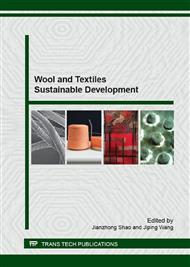[1]
Gupta, D., et al., Surface functionalization of wool using 172 nm UV excimer lamp. Journal of Applied Polymer Science. 2010: n/a-n/a.
DOI: 10.1002/app.32245
Google Scholar
[2]
Vanden, B.I., Towards an early warning system for oxidative degradation of protein fibres in historical tapestries by means of calibrated amino acid analysis. Journal of Archaeological Science. 2012. 39: pp.1349-1359.
DOI: 10.1016/j.jas.2011.12.033
Google Scholar
[3]
Aksakal, B., et al., The effect of temperature and water on the mechanical properties of wool fibres investigated with different experimental methods. Fibers and Polymers. 2009. 10: pp.673-680.
DOI: 10.1007/s12221-010-0673-9
Google Scholar
[4]
Wortmann, F.J., et al., Thermal denaturation and structural changes of alpha-helical proteins in keratins. Journal of structural biology. 2012. 177: pp.553-560.
DOI: 10.1016/j.jsb.2011.09.014
Google Scholar
[5]
Kavkler, K., et al., Impact of fungi on contemporary and accelerated aged wool fibres. Polymer Degradation and Stability. 2012. 97: pp.786-792.
DOI: 10.1016/j.polymdegradstab.2012.02.002
Google Scholar
[6]
Cardamone, J.M., Investigating the microstructure of keratin extracted from wool: Peptide sequence (MALDI-TOF/TOF) and protein conformation (FTIR). Journal of Molecular Structure. 2010. 969: pp.97-105.
DOI: 10.1016/j.molstruc.2010.01.048
Google Scholar
[7]
Millington, K., et al., The photodegradation of wool keratin II. Proposed mechanisms involving cystine. Journal of Photochemistry and Photobiology B: Biology. 1997. 39: pp.204-212.
DOI: 10.1016/s1011-1344(96)00020-6
Google Scholar
[8]
Smith, G.J., New trends in photobiology (invited review) photodegradation of keratin and other structural proteins. Journal of Photochemistry and Photobiology B: Biology. 1995. 27: pp.187-198.
DOI: 10.1016/1011-1344(94)07104-v
Google Scholar
[9]
Atav, R., The Use of New Technologies in Dyeing of Proteinous Fibers. (2013).
Google Scholar
[10]
Menefee, E., et al., Thermally-Induced Structural Changes in Wool. Textile Research Journal. 1965. 35: pp.801-812.
DOI: 10.1177/004051756503500904
Google Scholar
[11]
Xu, W., et al., Modification of wool fiber using steam explosion. European Polymer Journal. 2006. 42: pp.2168-2173.
DOI: 10.1016/j.eurpolymj.2006.03.026
Google Scholar
[12]
Bertini, F., et al., Wool keratin-polypropylene composites: Properties and thermal degradation. Polymer Degradation and Stability. 2013. 98: pp.980-987.
DOI: 10.1016/j.polymdegradstab.2013.02.011
Google Scholar
[13]
Xu, W., et al., Development and characterizations of super-fine wool powder. Powder Technology. 2004. 140: pp.136-140.
DOI: 10.1016/j.powtec.2003.12.010
Google Scholar
[14]
Tian, C., et al., Study on the thermal stability of wool treated with flame-retardant reagents. Thermochimica acta. 1996. 284: pp.435-439.
DOI: 10.1016/0040-6031(96)02839-0
Google Scholar
[15]
Niu, M., et al., Molecular structure and properties of wool fiber surface-grafted with nano-antibacterial materials. Spectrochimica Acta Part A: Molecular and Biomolecular Spectroscopy. 2012. 86: pp.289-293.
DOI: 10.1016/j.saa.2011.10.038
Google Scholar
[16]
Dyer, J.M., et al. Determination of Photo-oxidation Products Within Photoyellowed Bleached Wool Proteins. Photochemistry and photobiology. 2006. 82: pp.551-557.
DOI: 10.1562/2005-08-29-ra-663
Google Scholar
[17]
Pappas, C.S., et al., Identification and differentiation of goat and sheep milk based on diffuse reflectance infrared Fourier transform spectroscopy (DRIFTS) using cluster analysis. Food chemistry. 2008. 106: pp.1271-1277.
DOI: 10.1016/j.foodchem.2007.07.034
Google Scholar
[18]
Odlyha, M., Theodorakopoulos C, Campana R. Studies on woolen threads from historical tapestries. AUTEX Research Journal. 2007. 7: pp.9-18.
Google Scholar


